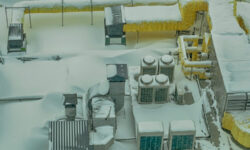In today’s environmentally conscious world, sustainability is a critical consideration in the construction and operation of commercial buildings. One of the most recognized standards for sustainable building is the Leadership in Energy and Environmental Design (LEED) certification.
LEED, developed by the U.S. Green Building Council (USGBC), provides a framework for healthy, efficient, and cost-saving green buildings. The role of Heating, Ventilation, and Air Conditioning (HVAC) systems is paramount among the various factors contributing to LEED certification. This article explores how HVAC systems influence LEED certification and why they are critical to achieving high performance in commercial buildings.
Heat Recovery Ventilation (HRV) and Energy Recovery Ventilation (ERV) systems are vital for modern buildings. They provide fresh air while conserving energy, helping maintain indoor air quality, reduce energy costs, and enhance overall comfort. Let’s explore what HRV and ERV systems are, their applications, and their benefits.
Read more →When disaster strikes a commercial building’s HVAC and plumbing systems, the consequences can be severe. Business operations can come to a standstill, and the safety of employees and customers can be compromised. Knowing how to respond promptly and effectively is crucial for minimizing damage and ensuring a quick return to normal operations. Here are comprehensive steps to do during an HVAC and plumbing system emergency in a commercial setting.
Read more →In the rapidly evolving landscape of commercial building management, efficiency and sustainability have become paramount. One of the key technologies driving these goals is the Building Automation System (BAS). BAS integrates various building systems, including heating, ventilation, and air conditioning (HVAC), to optimize performance, reduce energy consumption, and enhance occupant comfort. Let’s delve into BAS’s critical role in managing commercial HVAC systems.
Read more →The importance of commissioning in the performance of HVAC (Heating, Ventilation, and Air Conditioning) systems cannot be overstated. This process ensures that these systems are designed, installed, and functioning to meet the specific needs of a building and its occupants. Let’s dive into why commissioning is critical for HVAC system performance, its benefits, and some best practices to follow.
Read more →In the realm of modern comfort, few inventions rival the impact of air conditioning. From commercial buildings to offices, shopping malls to hospitals, air conditioning systems have become indispensable fixtures, regulating indoor temperatures and fostering environments conducive to productivity, relaxation, and well-being.
Read more →Subcontracting involves outsourcing tasks to third-party entities, leveraging external expertise, resources, and capabilities. Commercial construction relies heavily on subcontracting services to streamline operations and heighten efficiency. Among the various subcontracting services, commercial HVAC subcontracting emerges as a vital component. HVAC subcontracting services foster collaborative partnerships that fuel success and innovation across diverse industries. Let’s talk about the benefits and the importance of selecting the right commercial HVAC subcontractor to propel your business forward.
Read more →The importance of an efficient HVAC (Heating, Ventilation, and Air Conditioning) system cannot be overstated in commercial and industrial spaces. From maintaining comfortable indoor temperatures to ensuring optimal air quality, HVAC systems are critical in creating a conducive environment for employees and customers. However, achieving this requires more than just off-the-shelf solutions. Enter design-build HVAC systems – a customized approach that offers tailored solutions ideally suited to your business needs.
Read more →Emergency HVAC services can keep your business running smoothly. Every second counts in the business world and disruptions can be costly. A critical system that keeps your operations running smoothly is your HVAC (Heating, Ventilation, and Air Conditioning) system. It can lead to discomfort, lost productivity, and potential financial losses when it malfunctions or breaks down unexpectedly.
Read more →As a business owner or facility manager, you want to make sure your commercial building is safe and comfortable for its occupants. One vital aspect of achieving this comfort is effectively managing HVAC systems, especially during peak seasons. As the seasons change, so do the demands on your commercial HVAC system. Whether it’s the scorching heat of summer or the bitter cold of winter, maintaining a comfortable indoor environment in your commercial space is important for the well-being of employees and customers alike. In this blog, we’ll explore the challenges of managing HVAC during peak seasons and provide valuable tips to ensure your space remains comfortable year-round.
Read more →









